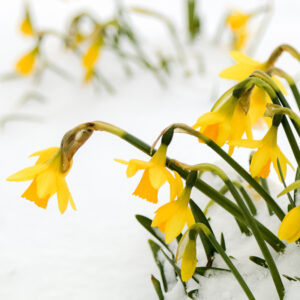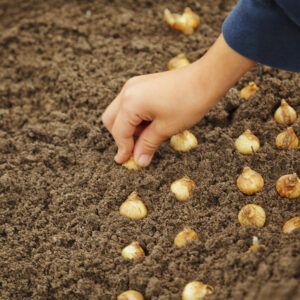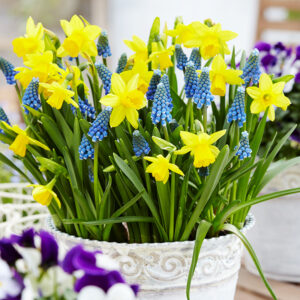Is there ever a time that it is too late to plant spring-blooming bulbs? Can flower bulbs be planted in early winter for spring blooms? Do flower bulbs need to establish roots before the ground freezes for winter? Can flower bulbs be planted after the first frost? These are common planting questions that many ask as we get later into the fall planting season. All of these questions can be answered by determining “When is it too late to plant bulbs in the fall?”
Knowing when you can plant bulbs in the fall is important to ensure you have blooms in spring. You may know the best time to plant bulbs in the fall. However, the best time to plant isn’t always the earliest or latest time they can be planted.
When is it too late to plant bulbs in the fall that will bloom in spring?
The last day for planting fall bulbs will vary each year based on when the ground freezes solid. If you are not able to dig into the ground with a shovel because it is frozen solid it is too late to plant for spring blooms. However, if the ground is not frozen solid and you can dig into it, you can plant fall bulbs.
If a light frost has occurred the ground is not frozen solid and fall bulbs like tulips and daffodils can be planted.
Even if there is a thin layer of snow on the ground there may still be an opportunity to plant bulbs. The ground is most likely still workable if the temperatures were mild before the snowfall occurred. Therefore, fall bulbs can often be planted after a light amount of snow.
In cold climates that experience a true winter of freezing temperatures, and snow spring-blooming bulbs can be planted as long as you can dig into the earth.
Tulips, daffodils, and other fall-planted bulb favorites do not need to establish roots prior to the ground freezing for winter. For this reason, they can be planted late into fall and even early winter. Bulbs that are planted in fall prefer and even require cold temperatures to grow their best, therefore, cold temperatures at planting will not harm them. If fall-planted bulbs are planted and the next day the ground freezes solid for winter, they will grow well.
Planting spring-blooming bulbs in warm climates
Gardeners in warm hardiness zones such as zones 7-10 can plant spring-blooming bulbs into early winter. Since the ground may not freeze solid in these areas, the planting season is a bit longer.
Spring-blooming bulbs will need to be planted at least 8 weeks before spring begins in your area so they can establish healthy roots before flower buds start to form. Spring-blooming bulbs should be planted by early to mid-January if flowers are desired in the upcoming spring season.
Root formation is important to establish healthy plants, cold temperatures are also needed to establish flower buds. Therefore, planting by mid-January is necessary for the formation of flower buds in spring. The majority of fall-planted bulbs that bloom in spring require 12-16 weeks of consistently cold temperatures (below 50 degrees during the day) in order to produce a flower bud. However, not all fall-planted bulbs require a long duration of cold temperatures in order to bloom. Suggestions for bulbs that grow best in warm to temperate climates can be found in our blog the Best Bulbs for Warm Climates.
What if it really is too late to plant spring-blooming bulbs?
Sometimes old man winter creeps up on us before we know it and the ground is frozen until spring. If you have found yourself in a situation where you have fall-planted bulbs and can’t plant them outside until spring, there is still hope for the future! The bulbs can be placed in the refrigerator until spring when they can be planted. This will give the bulbs the cold temperatures they need to produce a flower bud. If you choose to refrigerate the bulbs be sure to plant them in spring as soon as possible. This process is called forcing, more information on how to have success with forcing bulbs for spring blooms can be found here.
If you stumble upon forgotten fall bulbs in spring when you are cleaning your garage they can still be planted. Yes, fall-planted bulbs if they are still firm and intact can be planted in spring. However, they will not bloom that spring and will most likely only grow greenery. Since many fall-planted bulbs are reliable perennials they should return the following spring with blooms. The following winter they will get the required cold temperatures needed to produce a flower bud.
Bundle Up for Spring Blooms
Fall planted bulbs are quite easy to grow and rather hardy. If the cold temperatures aren’t your favorite, it’s still worth it to bundle up and plant even to the last minute. The blooms in spring will be worth the temporary discomfort of planting in the cold. So grab a shovel, your favorite fall bulbs, gloves, a mug of hot cocoa, and get to planting!





